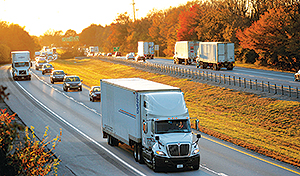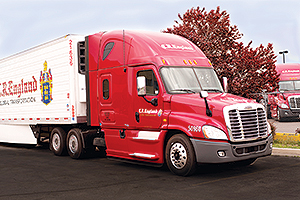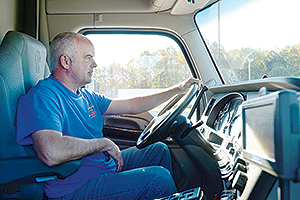Fleets Offer Salaries, Other Pay Models to Retain Drivers Amid Labor Shortage

Cents per mile remains the dominant form of pay in the for-hire truckload sector, but its dominance is not as strong as it once was as fleets embrace alternative pay models that take cyclicality out of driver pay.
Fleets that have implemented new payment methods said drivers appreciate the steady income.

At Smokey Point Distributing, about 75% of drivers switched over to a salary program that the carrier implemented last year. (Smokey Point Distributing)
At Smokey Point Distributing Inc., about 75% of drivers have switched over to a salary program that the carrier implemented last year, said Dan Wirkkala, president of the Arlington, Wash.-based flatbed carrier. Wirkkala said that throughout his 34 years with Smokey Point, he saw drivers coming in and asking for advances or having issues with their pay.
TALK ABOUT IT: On our Facebook page
Although they “loved to truck” and enjoyed the independence and freedom that the job provided, “they also had to earn a living,” Wirkkala said.
Smokey Point’s salary program requires a mileage minimum and offers drivers at least $65,000 a year. Drivers can earn more based on tenure, with an 11-year driver earning a base salary of $77,000 to $78,000, Wirkkala said. Drivers also can earn accessorial fees and mileage bonuses.
“Everything extra they accrue, which can range from $1 to $26,000, goes into their anniversary bonus bucket that is paid out every 12 months,” he said.
A growing number of companies are offering salaries for over-the-road, longhaul truck drivers, said Bob Costello, chief economist for American Trucking Associations.
“It isn’t a significant amount, but it is enough that I mention it,” Costello said, adding that the majority of fleets still pay by the mile, but some offer a variety of compensation packages.

Murrell
“It will range from cents per mile with bonuses, hourly pay or a salary,” he said.
Mark Murrell, co-founder of CarriersEdge, creator of the “Best Fleets to Drive For” program, first saw guaranteed pay emerge for drivers five years ago.
After that, the company started asking the distinct question, “ ‘Do you have guaranteed rate?’ There has definitely been a big increase in the number of fleets doing that,” he said.
Today, 35% of the finalists in the “Best Fleets” program have some type of a full guarantee in place, Murrell said.
Gordon Klemp, CEO of the National Transportation Institute, said he has seen an increase in guaranteed driver pay over the past 18 months.

Salaries and guaranteed pay programs offer truck drivers the comfort of knowing they won't see reduced paychecks due to heavy traffic or bad weather, experts say. (John Sommers II for Transport Topics)
“It isn’t always the total amount of compensation that has been a problem with the driver. It is the fact it doesn’t come in a regular interval,” he said.
Freight is seasonal and can vary significantly month to month, Costello said. In February 2018, there was a 4% to 6% decline from January because there are fewer days. “In March, you can see 10 to 15% increases,” he said.
Jeremy Reymer, CEO of DriverReach, said pay instability can be devastating to drivers, and letting drivers know what they can expect on a weekly basis can help them make informed decisions.
When John Wilbur, CEO of Roadmaster Group, joined the Glendale, Ariz.-based carrier in 2011, he examined drivers’ pay weekly for 52 weeks.
“I saw this extreme volatility in pay,” he said. “They’d get $600 this week, $1,400 next week and $800 the other week. If drivers are working, they should know how much money they are going to get.”
In 2012, Roadmaster launched a hybrid salary program that offers drivers a base rate per day and a mileage bonus.
“At the core of his pay is a daily base rate, so he knows if he is going to go out of the house and work for seven days, he is going to get at a bare minimum that pay every day,” Wilbur said, adding that driver turnover dropped by half once the salary program was implemented.
Roadmaster, as well as Smokey Point, are part of Addison, Texas-based Daseke Inc., which ranks No. 29 on the Transport Topics Top 100 list of the largest for-hire carriers in North America.
Roadmaster has three levels of base pay, based on drivers’ tenure and credentials. The highest level is about $1,500 a week, Wilbur said. Mileage bonuses start at 4 cents a mile and go up to 14 cents. Every year it increases a penny.
Overall, Wilbur experienced an increased cost per mile in terms of how much the drivers were paid, but his overall costs decreased based on recruiting, marketing and insurance.
“If you can dramatically reduce turnover, you’re going to see a benefit in other line items, which is what we did,” he said. “Some of them were immediate. Some, like insurance costs, took time.”

Reymer
Salaries and guaranteed pay programs give drivers the comfort of knowing they won’t be dinged for low freight, bad weather or bad traffic.
“Weekly minimums put pressure on companies to operate efficiently, otherwise they end up having to eat that productivity cost that wasn’t offset by extra revenue,” Reymer said. “It is putting skin in the game from the fleet’s perspective.”
Murrell of CarriersEdge, however, said some carriers are concerned that drivers aren’t going to work as hard if they know they’ll be getting paid.
Smokey Point built in tools that allow it to stay on top of driver productivity in real time and monitor dwell time and mileage.
“We can determine if it is operational decisions or driver performance that is causing that issue so we can be proactive,” Wirkkala said, adding that monitoring productivity has improved the fleet’s performance.

C.R. England pays its drivers by the mile but offers several levels of pay for inexperienced drivers participating in its training program. (C.R. England)
C.R. England pays its drivers by the mile but offers several levels of pay for inexperienced drivers participating in its training program. During phase 1, drivers earn a salary of $560 a week.
“For what we call phase 2, new drivers go through a teaming phase,” said Chad England, CEO of the Salt Lake City-based carrier. “They have a backstop of $700 a week for that period of training. Most of them, if they’re working, will make a heck of a lot more than that.”
C.R. England, which ranks No. 25 on the for-hire TT100, increased pay for linehaul, over-the-road drivers earlier this year.
“The amount ranges from 2 to 7 cents and is focused on teams,” England said, adding that the 2019 increase followed an increase last year. “We want to make sure our drivers don’t have a financial reason to leave us.”
England added that C.R. England saw strong improvement in driver retention and quality after its 2018 pay increase.
England said the carrier also offers a strong benefits package, which it provides separately from the cents-per-mile rate.
“We’ve seen carriers that bake that into their cents per mile. We don’t do that,” he said. “It can be really tricky for drivers to look at what they’ll actually get paid.”

Fleets are starting to embrace alternative pay models that take the cyclicality out of driver pay, industry experts say. (TruckPR/Flickr)
Driver pay can get complicated, ATA’s Costello said.
“Under the pay per mile, there are safety bonuses and fuel economy bonuses,” he said, adding that drivers also can receive good benefits. “Fleets get very aggravated at a driver that will leave for 2 cents more per mile but don’t look at the overall compensation package.”
Murrell said he’s stopped looking at specific bonuses.
“You could spend forever trying to figure out what they’re doing and compare it to other people,” he said. “If carriers have too many packages, that ends up being not only confusing to the driver but also it is punting responsibility to the driver.”
Murrell told Transport Topics that the driver shortage has encouraged fleets to get more creative with pay.
Smokey Point’s Wirkkala has focused on ways to incentivize his drivers to recruit other good drivers. The fleet rolled out a cents-per-mile bonus that is paid to the recruiter for each mile the new recruit drives, essentially giving drivers the opportunity to create a downline similar to a multilevel marketing company.
“I’m going to continue to pay a residual income for that driver’s productivity each month,” he said. “Our app will show the downline, the photo of the driver, a phone number and truck number so they can be a mentor.”
Offering drivers a salary has improved the recruiting and retention process at Roadmaster, Wilbur said. “We can keep our trucks full and can grow organically,” he said. “Drivers are a fixed cost. Not a variable. When people look at it that way, the paradigm will shift.”

